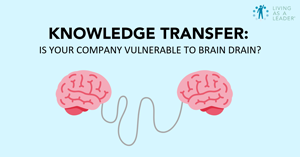
Knowledge transfer is becoming increasingly more critical as more and more veterans and baby boomers retire. According to a recent article on nextavenue.org:
“4 million boomers a year leave the workforce and boomers comprise 31 percent of workers; 56 percent of retiring boomers are in leadership positions.”
As this mass exodus occurs, few leaders and companies have designed or implemented knowledge transfer practices to minimize interruption and maximize continued success beyond a single individual or key individuals who hold key tribal knowledge.
Widely known as “Boomer Brain Drain,” this challenge isn’t just a result of a retiring workforce. Sudden grounds for termination, employee turnover, and unexpected illness can catch any company off-guard.
In one tragic example, a 40-something-year-old senior level Operations leader with 20+ years tenure in a company was diagnosed with terminal cancer while on vacation and never returned to work.
In another situation, a 70-something-year-old CEO, still fully engaged in the business with months remaining until his retirement, was struggling to imagine how the company would ever function and thrive without him in the future.
He had no succession strategy in place to help change his fear into success. He and others in the company were fully convinced that his knowledge was not something that could be shared or taught.
Similarly, there are far too many leaders who retain toxic employees because, after all “she knows how to perform a set of tasks far better than anyone else.”
Knowledge Transfer is Key
While each of these situations is vastly different, all of them could be prevented with a knowledge transfer plan.
An August 2018 blog on Maestro.com defines knowledge transfer as “a systematic and purposeful strategy for capturing critical knowledge from key personnel to store and share within an organization for maximum efficiency.”
Why Knowledge Transfer is Challenging for Organizations
In one recent study, it was reported that only 39% of organizations are considered effective at knowledge transfer. It was further reported that the primary challenges in transferring knowledge were:
- No formalized approach
- Lack of resources to dedicate to knowledge transfer (time, budget, people)
- Collaboration and consistency was missing
- Lack of accuracy or efficiency in capturing, translating, organizing and storing information
- Keeping information and knowledge centers relevant and current
Knowledge transfer is also a great example of something that is important and not urgent so it often gets pushed to the bottom of the priority list – until something happens and disruption affects the health of a team or entire company.
How to Start a Knowledge Transfer Plan at Your Company
So what can you do to take initial key steps toward knowledge transfer?
- Make a conscious decision to develop a knowledge transfer plan
- Identify the people/positions where loss of knowledge will be most damaging
- Develop an approach for collecting and storing information (consider mentors, training, coaching, shadowing, shared roles)
- Start with one key role
- Create a knowledge transfer team
- Establish metrics for measuring progress and completion
- Just do it!
Living As A Leader offers custom executive team development, executive coaching and custom consulting projects including the development of succession planning strategies.
Not only do we offer our flagship Leadership Development Series nationwide for leaders of all levels, we also offer custom executive coaching and consulting services. Let us help you map out a succession strategy so that your business can continue to grow and run smoothly in seasons of planned and unexpected change.